Comprehensive Research Project: Enhancing Indian Restaurants in Europe
VerifiedAdded on 2021/02/20
|18
|5225
|38
Project
AI Summary
This research project, presented as a proposal, focuses on strategies to improve Indian restaurants in Europe. The project begins with an introduction that provides an overview of Indian cuisine and its presence in Europe, highlighting the increasing number of Indian restaurants and the opportunities for growth. The research aims to identify the factors critical for success in the European market, determine the challenges these restaurants face, and explore effective improvement strategies. The methodology section outlines a qualitative research approach, emphasizing the use of interpretivism philosophy, inductive research, and descriptive research design. Data collection will involve both primary and secondary methods, including questionnaires and literature review. A random sampling technique will be employed, with 40 respondents selected to provide detailed information. The data analysis will involve thematic analysis, and the final sections will address ethical considerations, referencing, and presentation of the findings. The project seeks to provide insights and recommendations for Indian restaurant owners and aspiring entrepreneurs in the European market.
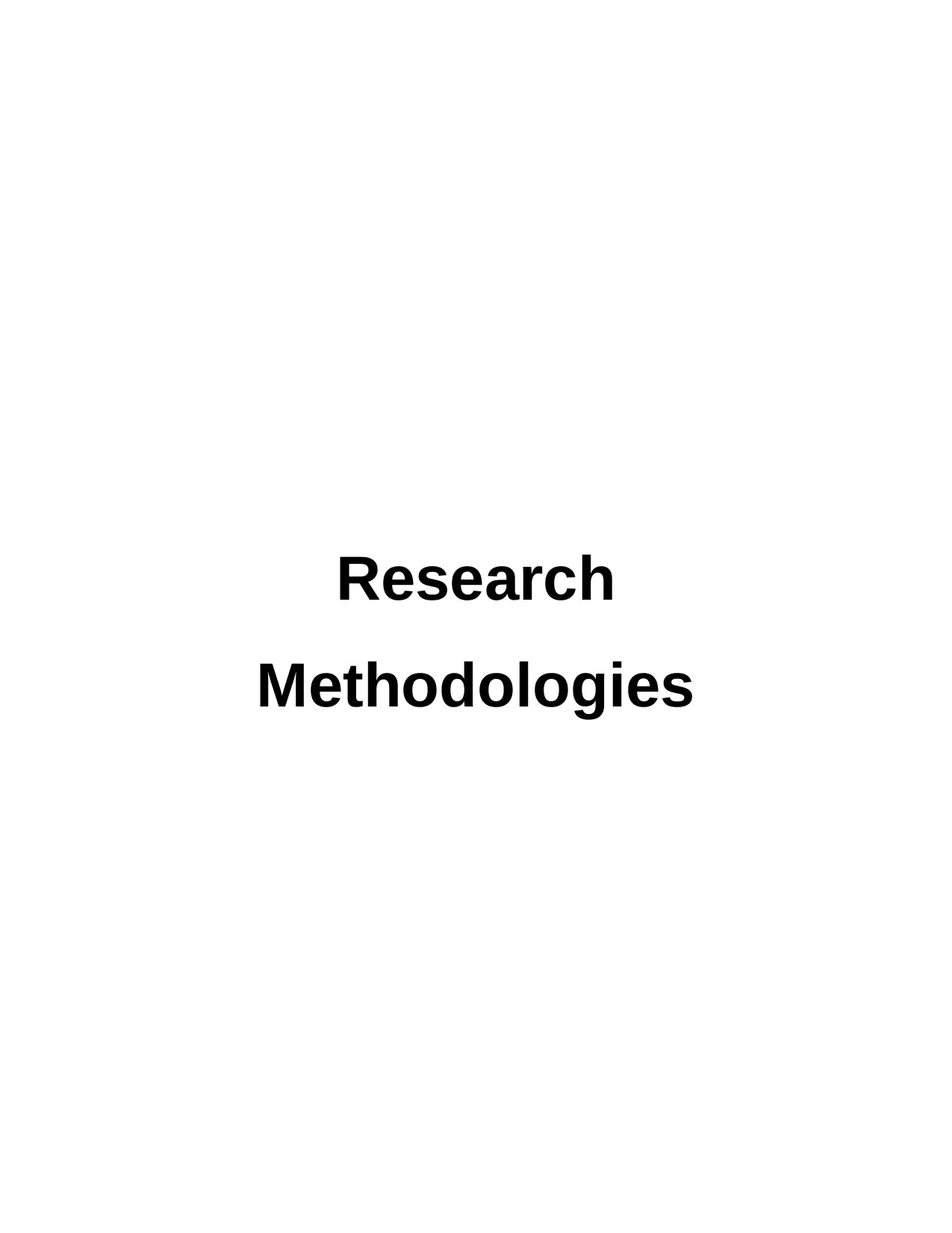
Research
Methodologies
Methodologies
Paraphrase This Document
Need a fresh take? Get an instant paraphrase of this document with our AI Paraphraser
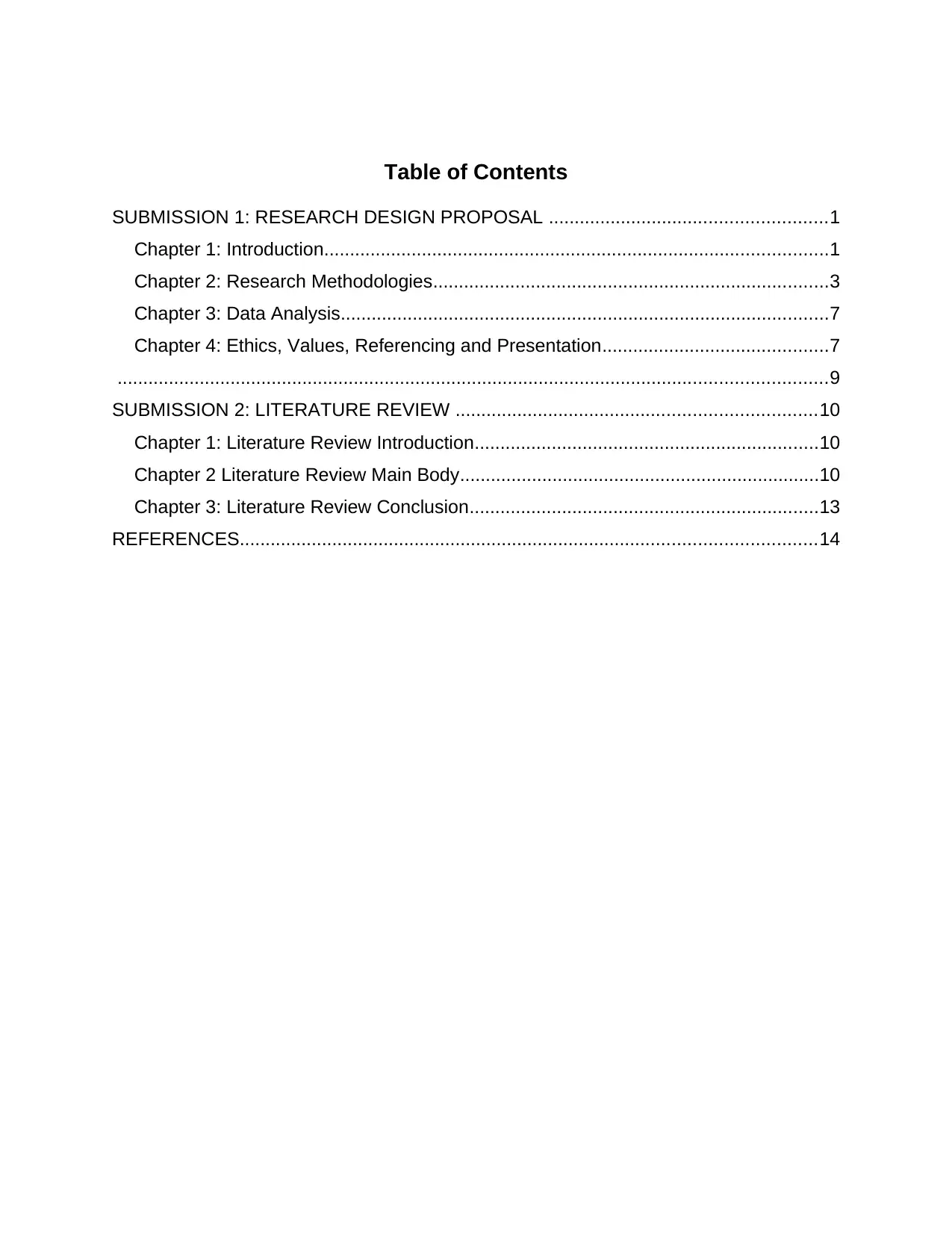
Table of Contents
SUBMISSION 1: RESEARCH DESIGN PROPOSAL ......................................................1
Chapter 1: Introduction..................................................................................................1
Chapter 2: Research Methodologies.............................................................................3
Chapter 3: Data Analysis...............................................................................................7
Chapter 4: Ethics, Values, Referencing and Presentation............................................7
..........................................................................................................................................9
SUBMISSION 2: LITERATURE REVIEW ......................................................................10
Chapter 1: Literature Review Introduction...................................................................10
Chapter 2 Literature Review Main Body......................................................................10
Chapter 3: Literature Review Conclusion....................................................................13
REFERENCES................................................................................................................14
SUBMISSION 1: RESEARCH DESIGN PROPOSAL ......................................................1
Chapter 1: Introduction..................................................................................................1
Chapter 2: Research Methodologies.............................................................................3
Chapter 3: Data Analysis...............................................................................................7
Chapter 4: Ethics, Values, Referencing and Presentation............................................7
..........................................................................................................................................9
SUBMISSION 2: LITERATURE REVIEW ......................................................................10
Chapter 1: Literature Review Introduction...................................................................10
Chapter 2 Literature Review Main Body......................................................................10
Chapter 3: Literature Review Conclusion....................................................................13
REFERENCES................................................................................................................14
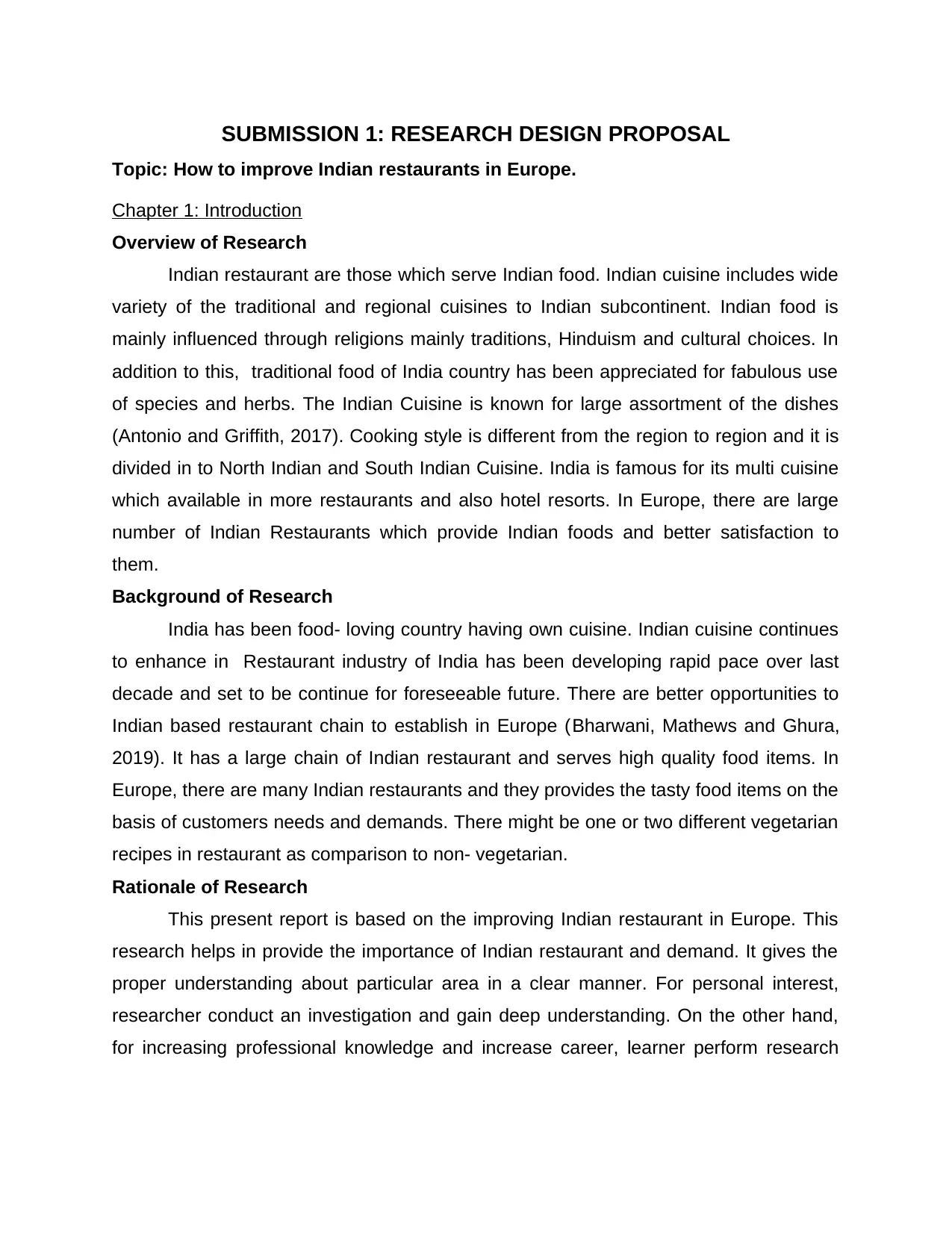
SUBMISSION 1: RESEARCH DESIGN PROPOSAL
Topic: How to improve Indian restaurants in Europe.
Chapter 1: Introduction
Overview of Research
Indian restaurant are those which serve Indian food. Indian cuisine includes wide
variety of the traditional and regional cuisines to Indian subcontinent. Indian food is
mainly influenced through religions mainly traditions, Hinduism and cultural choices. In
addition to this, traditional food of India country has been appreciated for fabulous use
of species and herbs. The Indian Cuisine is known for large assortment of the dishes
(Antonio and Griffith, 2017). Cooking style is different from the region to region and it is
divided in to North Indian and South Indian Cuisine. India is famous for its multi cuisine
which available in more restaurants and also hotel resorts. In Europe, there are large
number of Indian Restaurants which provide Indian foods and better satisfaction to
them.
Background of Research
India has been food- loving country having own cuisine. Indian cuisine continues
to enhance in Restaurant industry of India has been developing rapid pace over last
decade and set to be continue for foreseeable future. There are better opportunities to
Indian based restaurant chain to establish in Europe (Bharwani, Mathews and Ghura,
2019). It has a large chain of Indian restaurant and serves high quality food items. In
Europe, there are many Indian restaurants and they provides the tasty food items on the
basis of customers needs and demands. There might be one or two different vegetarian
recipes in restaurant as comparison to non- vegetarian.
Rationale of Research
This present report is based on the improving Indian restaurant in Europe. This
research helps in provide the importance of Indian restaurant and demand. It gives the
proper understanding about particular area in a clear manner. For personal interest,
researcher conduct an investigation and gain deep understanding. On the other hand,
for increasing professional knowledge and increase career, learner perform research
Topic: How to improve Indian restaurants in Europe.
Chapter 1: Introduction
Overview of Research
Indian restaurant are those which serve Indian food. Indian cuisine includes wide
variety of the traditional and regional cuisines to Indian subcontinent. Indian food is
mainly influenced through religions mainly traditions, Hinduism and cultural choices. In
addition to this, traditional food of India country has been appreciated for fabulous use
of species and herbs. The Indian Cuisine is known for large assortment of the dishes
(Antonio and Griffith, 2017). Cooking style is different from the region to region and it is
divided in to North Indian and South Indian Cuisine. India is famous for its multi cuisine
which available in more restaurants and also hotel resorts. In Europe, there are large
number of Indian Restaurants which provide Indian foods and better satisfaction to
them.
Background of Research
India has been food- loving country having own cuisine. Indian cuisine continues
to enhance in Restaurant industry of India has been developing rapid pace over last
decade and set to be continue for foreseeable future. There are better opportunities to
Indian based restaurant chain to establish in Europe (Bharwani, Mathews and Ghura,
2019). It has a large chain of Indian restaurant and serves high quality food items. In
Europe, there are many Indian restaurants and they provides the tasty food items on the
basis of customers needs and demands. There might be one or two different vegetarian
recipes in restaurant as comparison to non- vegetarian.
Rationale of Research
This present report is based on the improving Indian restaurant in Europe. This
research helps in provide the importance of Indian restaurant and demand. It gives the
proper understanding about particular area in a clear manner. For personal interest,
researcher conduct an investigation and gain deep understanding. On the other hand,
for increasing professional knowledge and increase career, learner perform research
⊘ This is a preview!⊘
Do you want full access?
Subscribe today to unlock all pages.

Trusted by 1+ million students worldwide
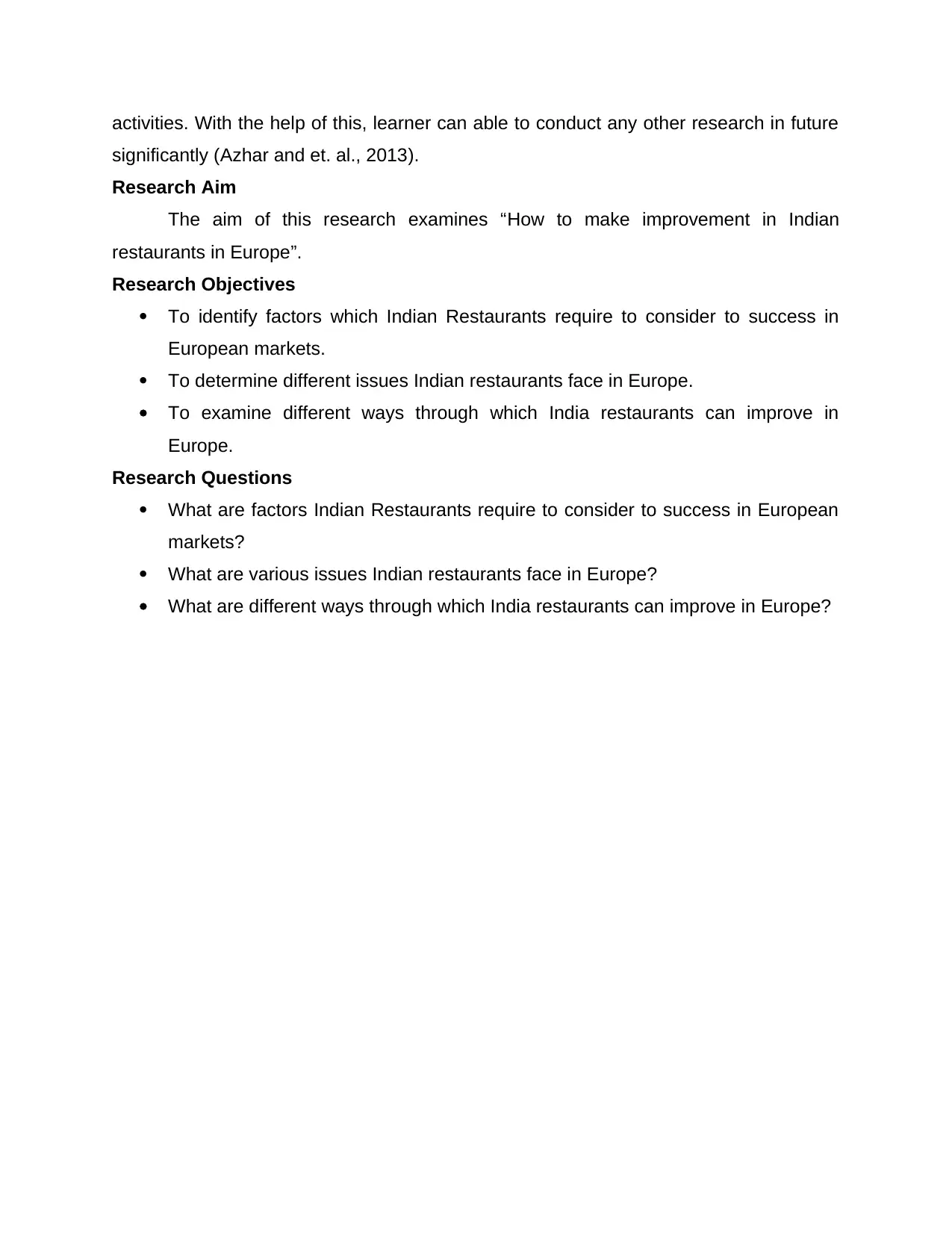
activities. With the help of this, learner can able to conduct any other research in future
significantly (Azhar and et. al., 2013).
Research Aim
The aim of this research examines “How to make improvement in Indian
restaurants in Europe”.
Research Objectives
To identify factors which Indian Restaurants require to consider to success in
European markets.
To determine different issues Indian restaurants face in Europe.
To examine different ways through which India restaurants can improve in
Europe.
Research Questions
What are factors Indian Restaurants require to consider to success in European
markets?
What are various issues Indian restaurants face in Europe?
What are different ways through which India restaurants can improve in Europe?
significantly (Azhar and et. al., 2013).
Research Aim
The aim of this research examines “How to make improvement in Indian
restaurants in Europe”.
Research Objectives
To identify factors which Indian Restaurants require to consider to success in
European markets.
To determine different issues Indian restaurants face in Europe.
To examine different ways through which India restaurants can improve in
Europe.
Research Questions
What are factors Indian Restaurants require to consider to success in European
markets?
What are various issues Indian restaurants face in Europe?
What are different ways through which India restaurants can improve in Europe?
Paraphrase This Document
Need a fresh take? Get an instant paraphrase of this document with our AI Paraphraser
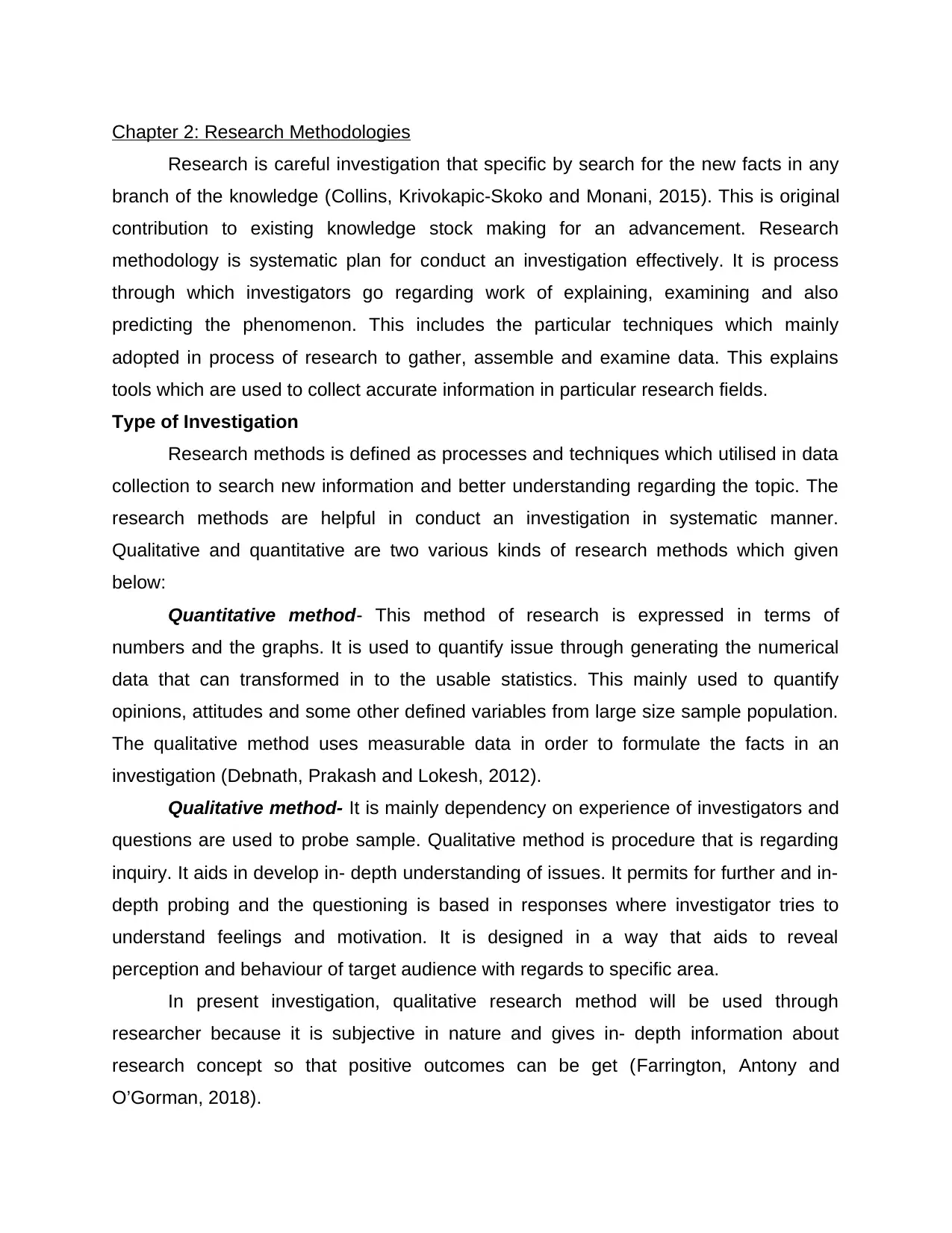
Chapter 2: Research Methodologies
Research is careful investigation that specific by search for the new facts in any
branch of the knowledge (Collins, Krivokapic-Skoko and Monani, 2015). This is original
contribution to existing knowledge stock making for an advancement. Research
methodology is systematic plan for conduct an investigation effectively. It is process
through which investigators go regarding work of explaining, examining and also
predicting the phenomenon. This includes the particular techniques which mainly
adopted in process of research to gather, assemble and examine data. This explains
tools which are used to collect accurate information in particular research fields.
Type of Investigation
Research methods is defined as processes and techniques which utilised in data
collection to search new information and better understanding regarding the topic. The
research methods are helpful in conduct an investigation in systematic manner.
Qualitative and quantitative are two various kinds of research methods which given
below:
Quantitative method- This method of research is expressed in terms of
numbers and the graphs. It is used to quantify issue through generating the numerical
data that can transformed in to the usable statistics. This mainly used to quantify
opinions, attitudes and some other defined variables from large size sample population.
The qualitative method uses measurable data in order to formulate the facts in an
investigation (Debnath, Prakash and Lokesh, 2012).
Qualitative method- It is mainly dependency on experience of investigators and
questions are used to probe sample. Qualitative method is procedure that is regarding
inquiry. It aids in develop in- depth understanding of issues. It permits for further and in-
depth probing and the questioning is based in responses where investigator tries to
understand feelings and motivation. It is designed in a way that aids to reveal
perception and behaviour of target audience with regards to specific area.
In present investigation, qualitative research method will be used through
researcher because it is subjective in nature and gives in- depth information about
research concept so that positive outcomes can be get (Farrington, Antony and
O’Gorman, 2018).
Research is careful investigation that specific by search for the new facts in any
branch of the knowledge (Collins, Krivokapic-Skoko and Monani, 2015). This is original
contribution to existing knowledge stock making for an advancement. Research
methodology is systematic plan for conduct an investigation effectively. It is process
through which investigators go regarding work of explaining, examining and also
predicting the phenomenon. This includes the particular techniques which mainly
adopted in process of research to gather, assemble and examine data. This explains
tools which are used to collect accurate information in particular research fields.
Type of Investigation
Research methods is defined as processes and techniques which utilised in data
collection to search new information and better understanding regarding the topic. The
research methods are helpful in conduct an investigation in systematic manner.
Qualitative and quantitative are two various kinds of research methods which given
below:
Quantitative method- This method of research is expressed in terms of
numbers and the graphs. It is used to quantify issue through generating the numerical
data that can transformed in to the usable statistics. This mainly used to quantify
opinions, attitudes and some other defined variables from large size sample population.
The qualitative method uses measurable data in order to formulate the facts in an
investigation (Debnath, Prakash and Lokesh, 2012).
Qualitative method- It is mainly dependency on experience of investigators and
questions are used to probe sample. Qualitative method is procedure that is regarding
inquiry. It aids in develop in- depth understanding of issues. It permits for further and in-
depth probing and the questioning is based in responses where investigator tries to
understand feelings and motivation. It is designed in a way that aids to reveal
perception and behaviour of target audience with regards to specific area.
In present investigation, qualitative research method will be used through
researcher because it is subjective in nature and gives in- depth information about
research concept so that positive outcomes can be get (Farrington, Antony and
O’Gorman, 2018).
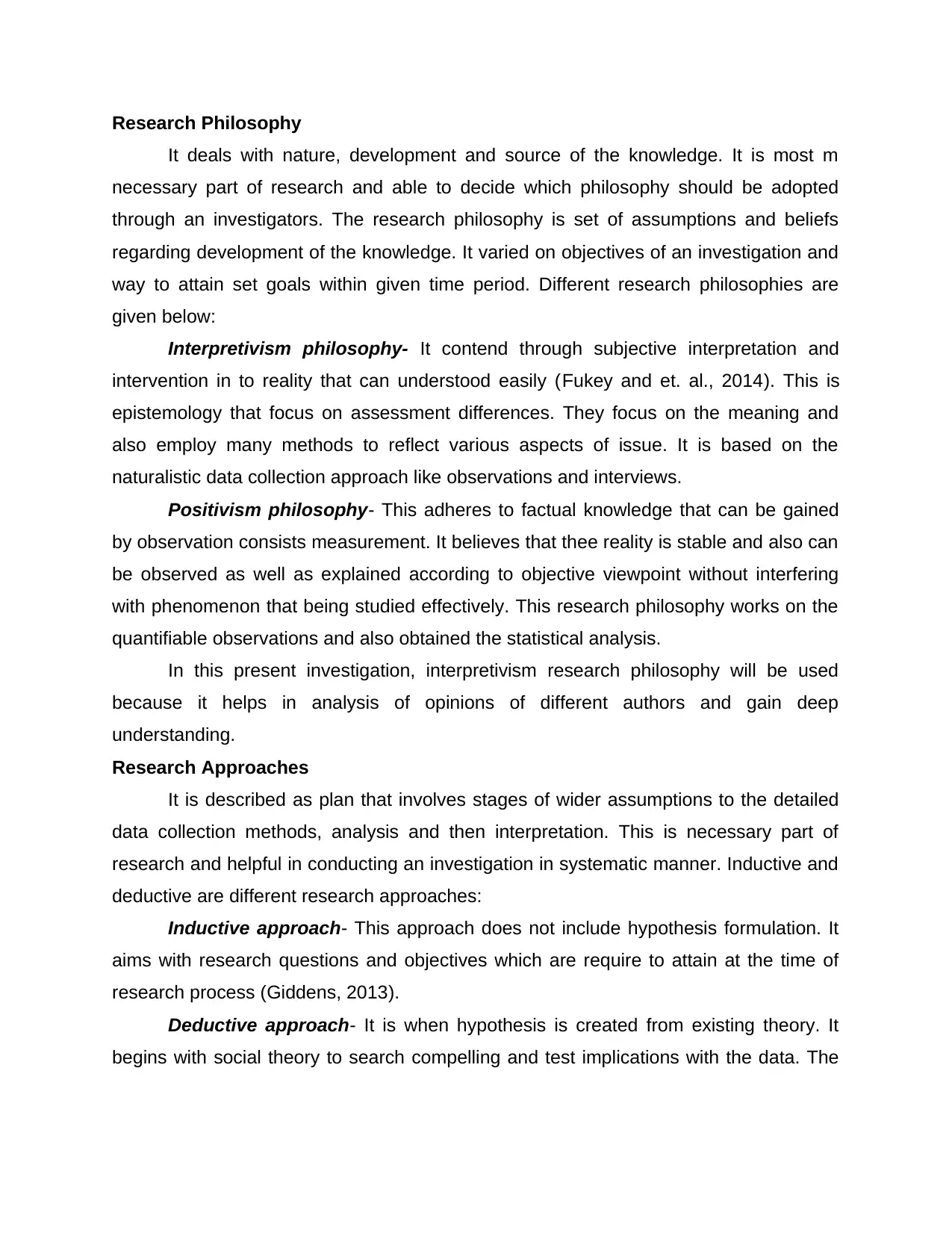
Research Philosophy
It deals with nature, development and source of the knowledge. It is most m
necessary part of research and able to decide which philosophy should be adopted
through an investigators. The research philosophy is set of assumptions and beliefs
regarding development of the knowledge. It varied on objectives of an investigation and
way to attain set goals within given time period. Different research philosophies are
given below:
Interpretivism philosophy- It contend through subjective interpretation and
intervention in to reality that can understood easily (Fukey and et. al., 2014). This is
epistemology that focus on assessment differences. They focus on the meaning and
also employ many methods to reflect various aspects of issue. It is based on the
naturalistic data collection approach like observations and interviews.
Positivism philosophy- This adheres to factual knowledge that can be gained
by observation consists measurement. It believes that thee reality is stable and also can
be observed as well as explained according to objective viewpoint without interfering
with phenomenon that being studied effectively. This research philosophy works on the
quantifiable observations and also obtained the statistical analysis.
In this present investigation, interpretivism research philosophy will be used
because it helps in analysis of opinions of different authors and gain deep
understanding.
Research Approaches
It is described as plan that involves stages of wider assumptions to the detailed
data collection methods, analysis and then interpretation. This is necessary part of
research and helpful in conducting an investigation in systematic manner. Inductive and
deductive are different research approaches:
Inductive approach- This approach does not include hypothesis formulation. It
aims with research questions and objectives which are require to attain at the time of
research process (Giddens, 2013).
Deductive approach- It is when hypothesis is created from existing theory. It
begins with social theory to search compelling and test implications with the data. The
It deals with nature, development and source of the knowledge. It is most m
necessary part of research and able to decide which philosophy should be adopted
through an investigators. The research philosophy is set of assumptions and beliefs
regarding development of the knowledge. It varied on objectives of an investigation and
way to attain set goals within given time period. Different research philosophies are
given below:
Interpretivism philosophy- It contend through subjective interpretation and
intervention in to reality that can understood easily (Fukey and et. al., 2014). This is
epistemology that focus on assessment differences. They focus on the meaning and
also employ many methods to reflect various aspects of issue. It is based on the
naturalistic data collection approach like observations and interviews.
Positivism philosophy- This adheres to factual knowledge that can be gained
by observation consists measurement. It believes that thee reality is stable and also can
be observed as well as explained according to objective viewpoint without interfering
with phenomenon that being studied effectively. This research philosophy works on the
quantifiable observations and also obtained the statistical analysis.
In this present investigation, interpretivism research philosophy will be used
because it helps in analysis of opinions of different authors and gain deep
understanding.
Research Approaches
It is described as plan that involves stages of wider assumptions to the detailed
data collection methods, analysis and then interpretation. This is necessary part of
research and helpful in conducting an investigation in systematic manner. Inductive and
deductive are different research approaches:
Inductive approach- This approach does not include hypothesis formulation. It
aims with research questions and objectives which are require to attain at the time of
research process (Giddens, 2013).
Deductive approach- It is when hypothesis is created from existing theory. It
begins with social theory to search compelling and test implications with the data. The
⊘ This is a preview!⊘
Do you want full access?
Subscribe today to unlock all pages.

Trusted by 1+ million students worldwide
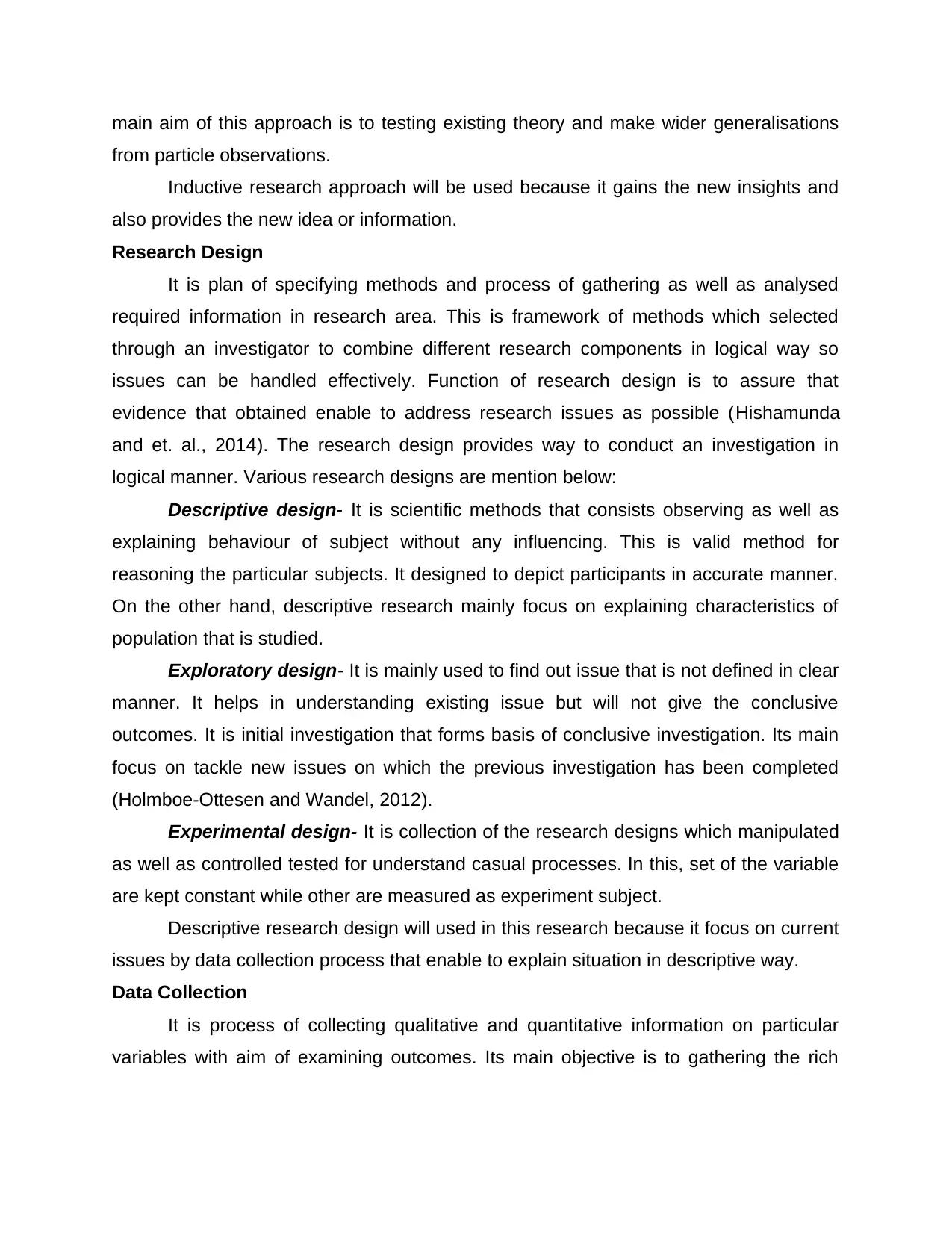
main aim of this approach is to testing existing theory and make wider generalisations
from particle observations.
Inductive research approach will be used because it gains the new insights and
also provides the new idea or information.
Research Design
It is plan of specifying methods and process of gathering as well as analysed
required information in research area. This is framework of methods which selected
through an investigator to combine different research components in logical way so
issues can be handled effectively. Function of research design is to assure that
evidence that obtained enable to address research issues as possible (Hishamunda
and et. al., 2014). The research design provides way to conduct an investigation in
logical manner. Various research designs are mention below:
Descriptive design- It is scientific methods that consists observing as well as
explaining behaviour of subject without any influencing. This is valid method for
reasoning the particular subjects. It designed to depict participants in accurate manner.
On the other hand, descriptive research mainly focus on explaining characteristics of
population that is studied.
Exploratory design- It is mainly used to find out issue that is not defined in clear
manner. It helps in understanding existing issue but will not give the conclusive
outcomes. It is initial investigation that forms basis of conclusive investigation. Its main
focus on tackle new issues on which the previous investigation has been completed
(Holmboe-Ottesen and Wandel, 2012).
Experimental design- It is collection of the research designs which manipulated
as well as controlled tested for understand casual processes. In this, set of the variable
are kept constant while other are measured as experiment subject.
Descriptive research design will used in this research because it focus on current
issues by data collection process that enable to explain situation in descriptive way.
Data Collection
It is process of collecting qualitative and quantitative information on particular
variables with aim of examining outcomes. Its main objective is to gathering the rich
from particle observations.
Inductive research approach will be used because it gains the new insights and
also provides the new idea or information.
Research Design
It is plan of specifying methods and process of gathering as well as analysed
required information in research area. This is framework of methods which selected
through an investigator to combine different research components in logical way so
issues can be handled effectively. Function of research design is to assure that
evidence that obtained enable to address research issues as possible (Hishamunda
and et. al., 2014). The research design provides way to conduct an investigation in
logical manner. Various research designs are mention below:
Descriptive design- It is scientific methods that consists observing as well as
explaining behaviour of subject without any influencing. This is valid method for
reasoning the particular subjects. It designed to depict participants in accurate manner.
On the other hand, descriptive research mainly focus on explaining characteristics of
population that is studied.
Exploratory design- It is mainly used to find out issue that is not defined in clear
manner. It helps in understanding existing issue but will not give the conclusive
outcomes. It is initial investigation that forms basis of conclusive investigation. Its main
focus on tackle new issues on which the previous investigation has been completed
(Holmboe-Ottesen and Wandel, 2012).
Experimental design- It is collection of the research designs which manipulated
as well as controlled tested for understand casual processes. In this, set of the variable
are kept constant while other are measured as experiment subject.
Descriptive research design will used in this research because it focus on current
issues by data collection process that enable to explain situation in descriptive way.
Data Collection
It is process of collecting qualitative and quantitative information on particular
variables with aim of examining outcomes. Its main objective is to gathering the rich
Paraphrase This Document
Need a fresh take? Get an instant paraphrase of this document with our AI Paraphraser
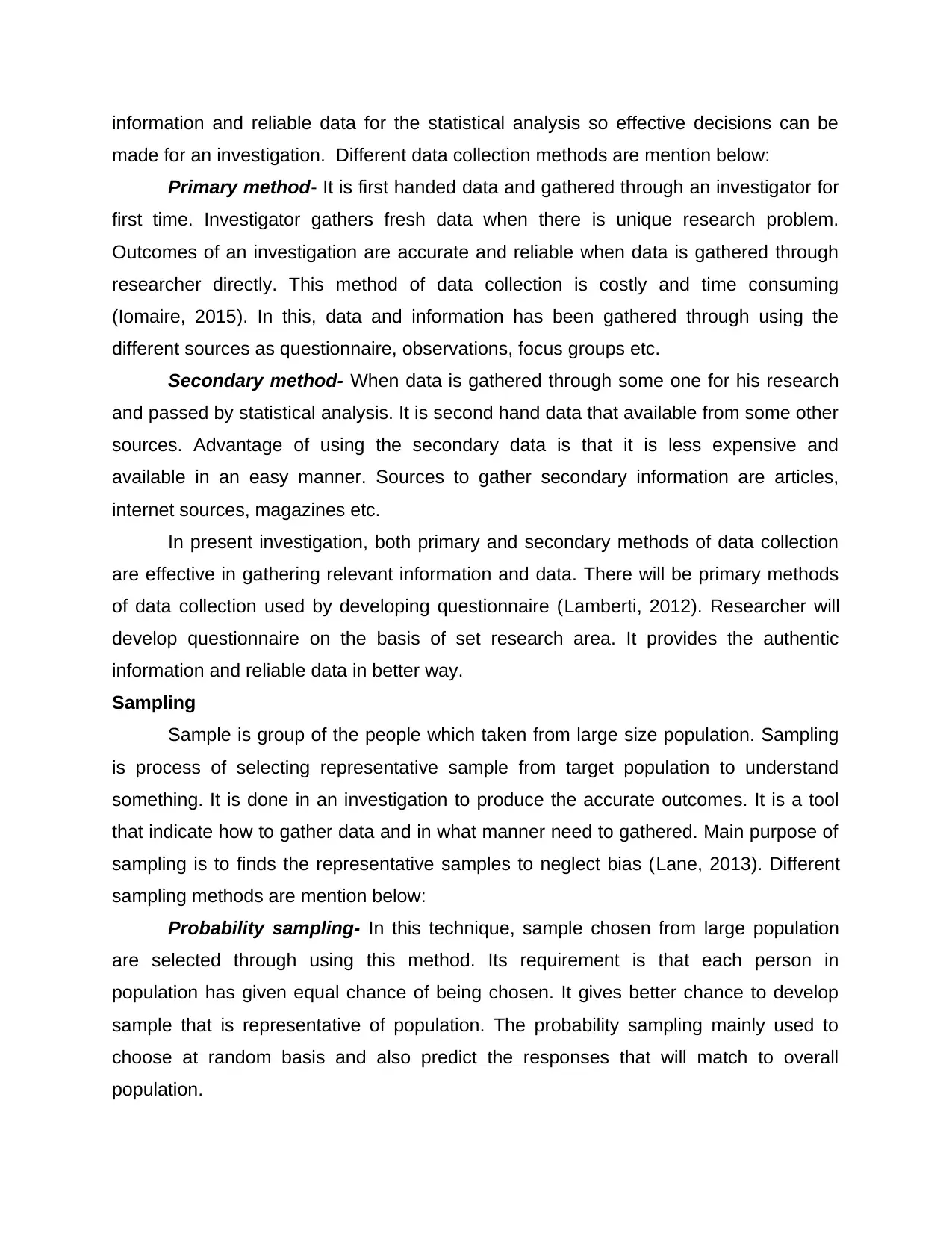
information and reliable data for the statistical analysis so effective decisions can be
made for an investigation. Different data collection methods are mention below:
Primary method- It is first handed data and gathered through an investigator for
first time. Investigator gathers fresh data when there is unique research problem.
Outcomes of an investigation are accurate and reliable when data is gathered through
researcher directly. This method of data collection is costly and time consuming
(Iomaire, 2015). In this, data and information has been gathered through using the
different sources as questionnaire, observations, focus groups etc.
Secondary method- When data is gathered through some one for his research
and passed by statistical analysis. It is second hand data that available from some other
sources. Advantage of using the secondary data is that it is less expensive and
available in an easy manner. Sources to gather secondary information are articles,
internet sources, magazines etc.
In present investigation, both primary and secondary methods of data collection
are effective in gathering relevant information and data. There will be primary methods
of data collection used by developing questionnaire (Lamberti, 2012). Researcher will
develop questionnaire on the basis of set research area. It provides the authentic
information and reliable data in better way.
Sampling
Sample is group of the people which taken from large size population. Sampling
is process of selecting representative sample from target population to understand
something. It is done in an investigation to produce the accurate outcomes. It is a tool
that indicate how to gather data and in what manner need to gathered. Main purpose of
sampling is to finds the representative samples to neglect bias (Lane, 2013). Different
sampling methods are mention below:
Probability sampling- In this technique, sample chosen from large population
are selected through using this method. Its requirement is that each person in
population has given equal chance of being chosen. It gives better chance to develop
sample that is representative of population. The probability sampling mainly used to
choose at random basis and also predict the responses that will match to overall
population.
made for an investigation. Different data collection methods are mention below:
Primary method- It is first handed data and gathered through an investigator for
first time. Investigator gathers fresh data when there is unique research problem.
Outcomes of an investigation are accurate and reliable when data is gathered through
researcher directly. This method of data collection is costly and time consuming
(Iomaire, 2015). In this, data and information has been gathered through using the
different sources as questionnaire, observations, focus groups etc.
Secondary method- When data is gathered through some one for his research
and passed by statistical analysis. It is second hand data that available from some other
sources. Advantage of using the secondary data is that it is less expensive and
available in an easy manner. Sources to gather secondary information are articles,
internet sources, magazines etc.
In present investigation, both primary and secondary methods of data collection
are effective in gathering relevant information and data. There will be primary methods
of data collection used by developing questionnaire (Lamberti, 2012). Researcher will
develop questionnaire on the basis of set research area. It provides the authentic
information and reliable data in better way.
Sampling
Sample is group of the people which taken from large size population. Sampling
is process of selecting representative sample from target population to understand
something. It is done in an investigation to produce the accurate outcomes. It is a tool
that indicate how to gather data and in what manner need to gathered. Main purpose of
sampling is to finds the representative samples to neglect bias (Lane, 2013). Different
sampling methods are mention below:
Probability sampling- In this technique, sample chosen from large population
are selected through using this method. Its requirement is that each person in
population has given equal chance of being chosen. It gives better chance to develop
sample that is representative of population. The probability sampling mainly used to
choose at random basis and also predict the responses that will match to overall
population.
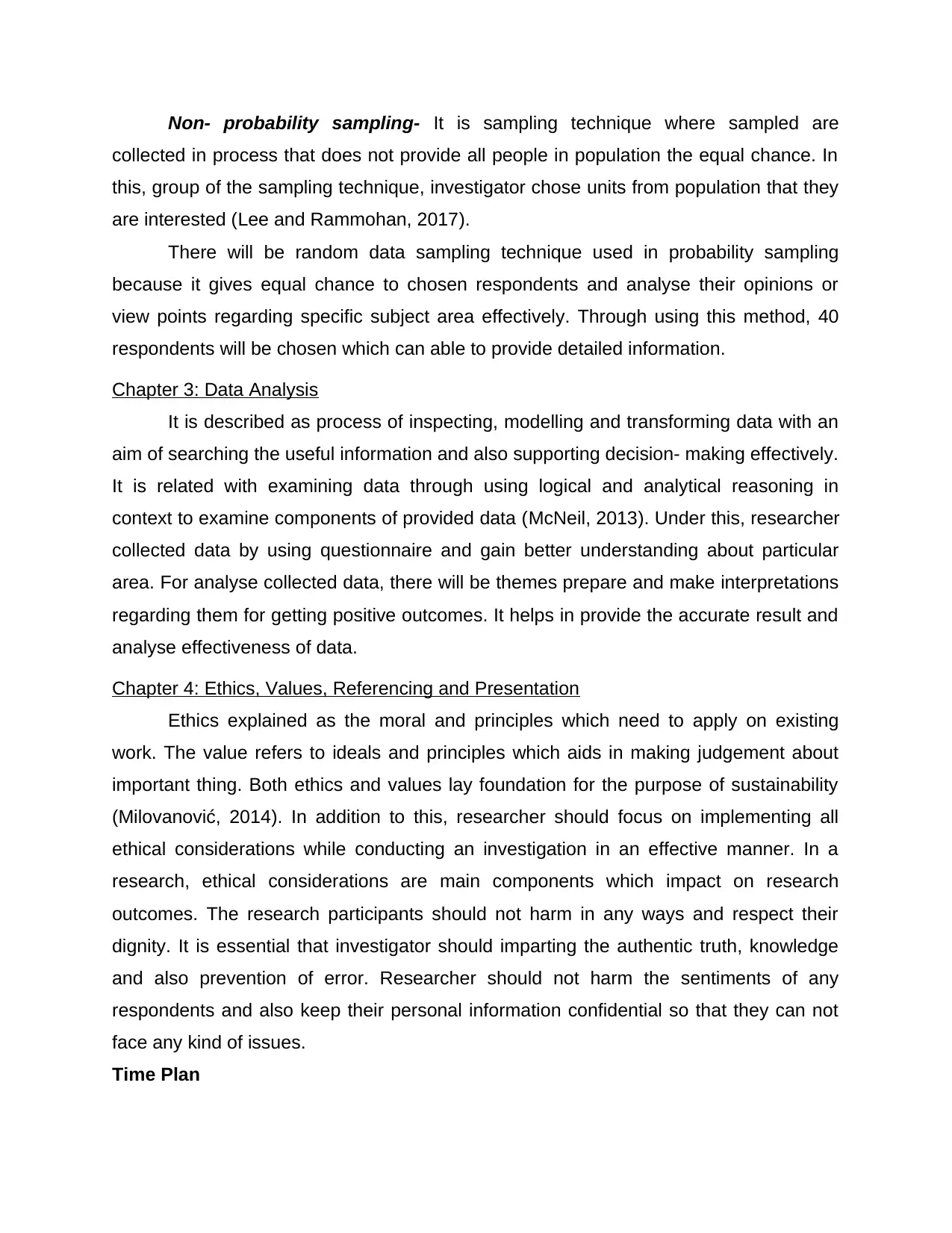
Non- probability sampling- It is sampling technique where sampled are
collected in process that does not provide all people in population the equal chance. In
this, group of the sampling technique, investigator chose units from population that they
are interested (Lee and Rammohan, 2017).
There will be random data sampling technique used in probability sampling
because it gives equal chance to chosen respondents and analyse their opinions or
view points regarding specific subject area effectively. Through using this method, 40
respondents will be chosen which can able to provide detailed information.
Chapter 3: Data Analysis
It is described as process of inspecting, modelling and transforming data with an
aim of searching the useful information and also supporting decision- making effectively.
It is related with examining data through using logical and analytical reasoning in
context to examine components of provided data (McNeil, 2013). Under this, researcher
collected data by using questionnaire and gain better understanding about particular
area. For analyse collected data, there will be themes prepare and make interpretations
regarding them for getting positive outcomes. It helps in provide the accurate result and
analyse effectiveness of data.
Chapter 4: Ethics, Values, Referencing and Presentation
Ethics explained as the moral and principles which need to apply on existing
work. The value refers to ideals and principles which aids in making judgement about
important thing. Both ethics and values lay foundation for the purpose of sustainability
(Milovanović, 2014). In addition to this, researcher should focus on implementing all
ethical considerations while conducting an investigation in an effective manner. In a
research, ethical considerations are main components which impact on research
outcomes. The research participants should not harm in any ways and respect their
dignity. It is essential that investigator should imparting the authentic truth, knowledge
and also prevention of error. Researcher should not harm the sentiments of any
respondents and also keep their personal information confidential so that they can not
face any kind of issues.
Time Plan
collected in process that does not provide all people in population the equal chance. In
this, group of the sampling technique, investigator chose units from population that they
are interested (Lee and Rammohan, 2017).
There will be random data sampling technique used in probability sampling
because it gives equal chance to chosen respondents and analyse their opinions or
view points regarding specific subject area effectively. Through using this method, 40
respondents will be chosen which can able to provide detailed information.
Chapter 3: Data Analysis
It is described as process of inspecting, modelling and transforming data with an
aim of searching the useful information and also supporting decision- making effectively.
It is related with examining data through using logical and analytical reasoning in
context to examine components of provided data (McNeil, 2013). Under this, researcher
collected data by using questionnaire and gain better understanding about particular
area. For analyse collected data, there will be themes prepare and make interpretations
regarding them for getting positive outcomes. It helps in provide the accurate result and
analyse effectiveness of data.
Chapter 4: Ethics, Values, Referencing and Presentation
Ethics explained as the moral and principles which need to apply on existing
work. The value refers to ideals and principles which aids in making judgement about
important thing. Both ethics and values lay foundation for the purpose of sustainability
(Milovanović, 2014). In addition to this, researcher should focus on implementing all
ethical considerations while conducting an investigation in an effective manner. In a
research, ethical considerations are main components which impact on research
outcomes. The research participants should not harm in any ways and respect their
dignity. It is essential that investigator should imparting the authentic truth, knowledge
and also prevention of error. Researcher should not harm the sentiments of any
respondents and also keep their personal information confidential so that they can not
face any kind of issues.
Time Plan
⊘ This is a preview!⊘
Do you want full access?
Subscribe today to unlock all pages.

Trusted by 1+ million students worldwide
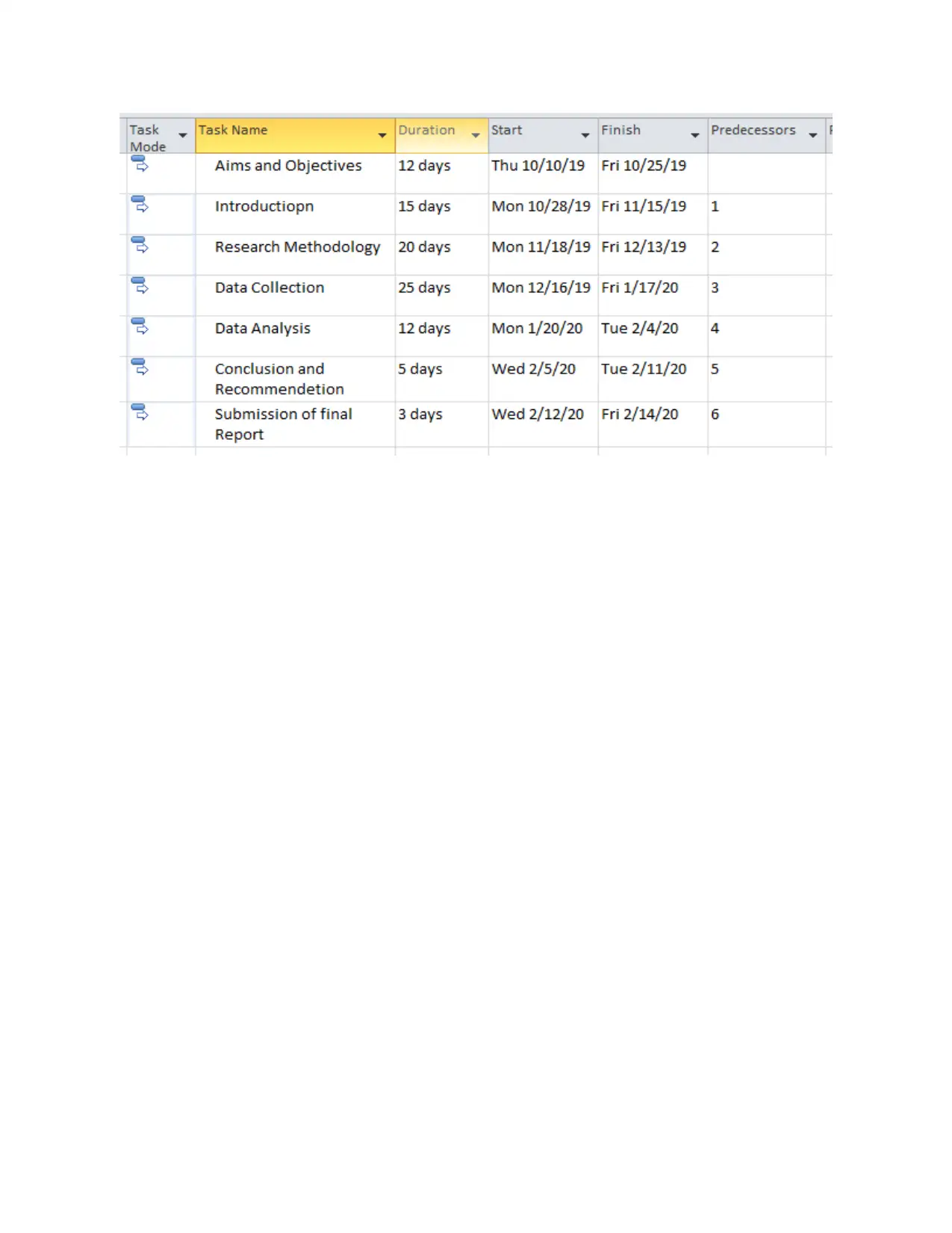
Paraphrase This Document
Need a fresh take? Get an instant paraphrase of this document with our AI Paraphraser
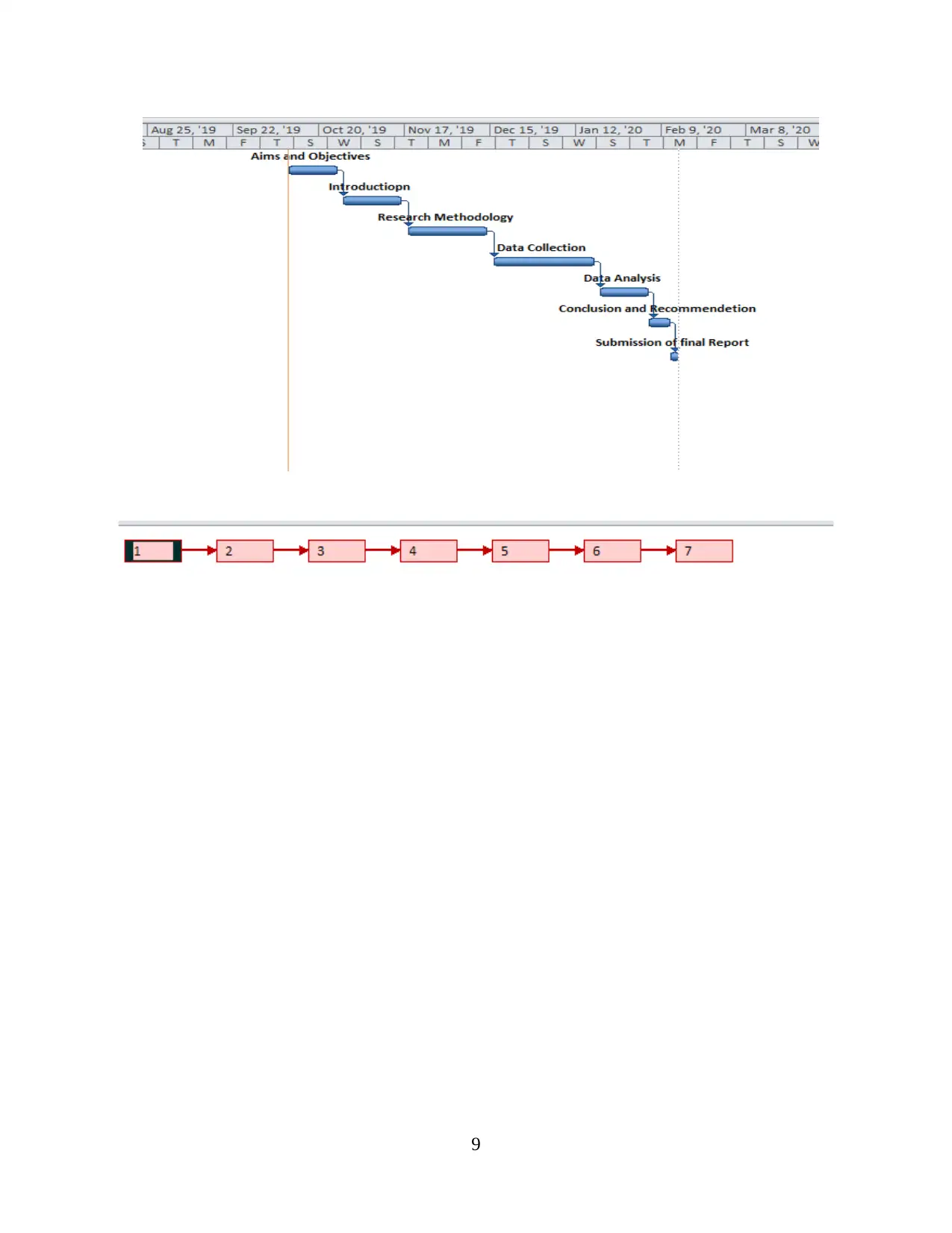
9
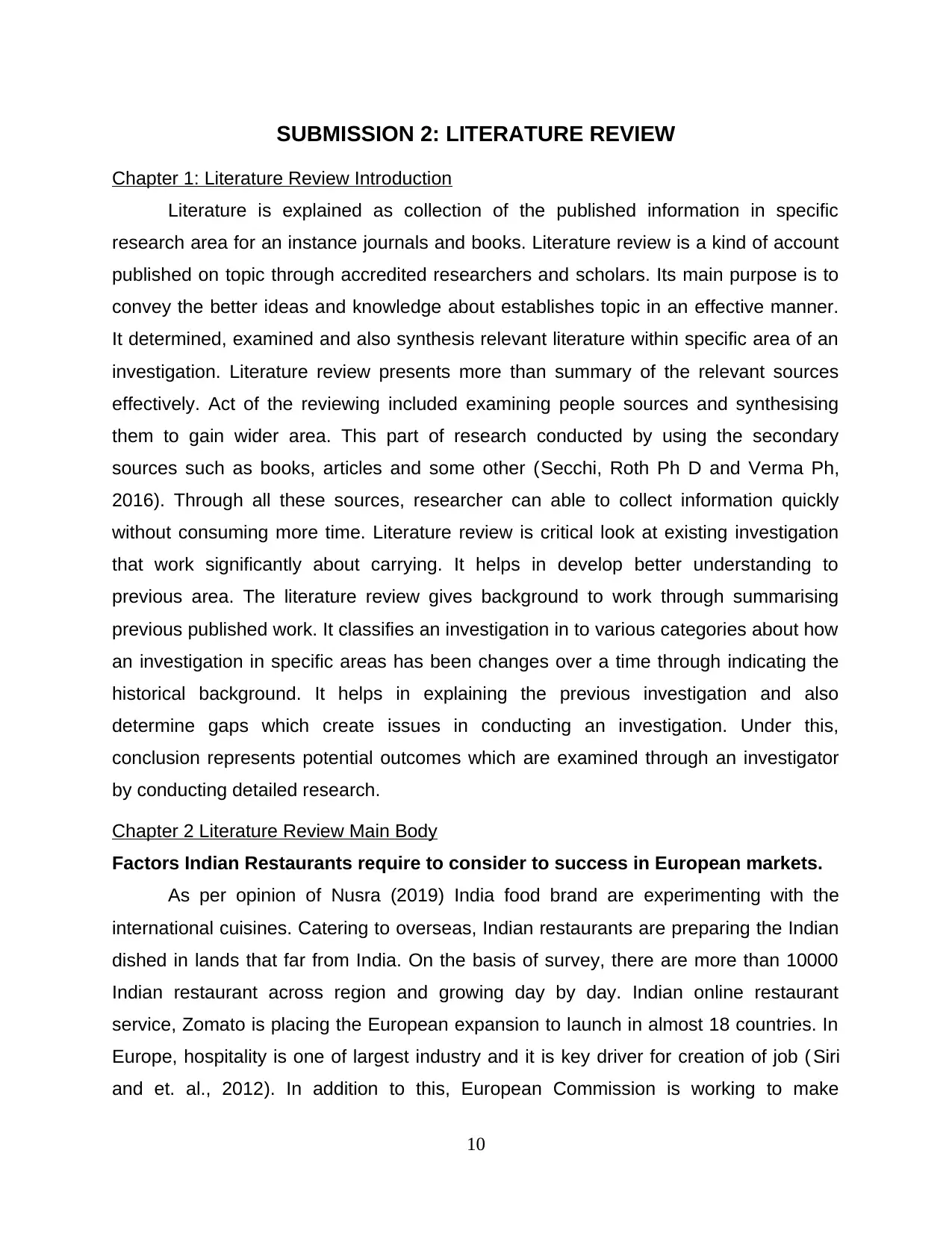
SUBMISSION 2: LITERATURE REVIEW
Chapter 1: Literature Review Introduction
Literature is explained as collection of the published information in specific
research area for an instance journals and books. Literature review is a kind of account
published on topic through accredited researchers and scholars. Its main purpose is to
convey the better ideas and knowledge about establishes topic in an effective manner.
It determined, examined and also synthesis relevant literature within specific area of an
investigation. Literature review presents more than summary of the relevant sources
effectively. Act of the reviewing included examining people sources and synthesising
them to gain wider area. This part of research conducted by using the secondary
sources such as books, articles and some other (Secchi, Roth Ph D and Verma Ph,
2016). Through all these sources, researcher can able to collect information quickly
without consuming more time. Literature review is critical look at existing investigation
that work significantly about carrying. It helps in develop better understanding to
previous area. The literature review gives background to work through summarising
previous published work. It classifies an investigation in to various categories about how
an investigation in specific areas has been changes over a time through indicating the
historical background. It helps in explaining the previous investigation and also
determine gaps which create issues in conducting an investigation. Under this,
conclusion represents potential outcomes which are examined through an investigator
by conducting detailed research.
Chapter 2 Literature Review Main Body
Factors Indian Restaurants require to consider to success in European markets.
As per opinion of Nusra (2019) India food brand are experimenting with the
international cuisines. Catering to overseas, Indian restaurants are preparing the Indian
dished in lands that far from India. On the basis of survey, there are more than 10000
Indian restaurant across region and growing day by day. Indian online restaurant
service, Zomato is placing the European expansion to launch in almost 18 countries. In
Europe, hospitality is one of largest industry and it is key driver for creation of job ( Siri
and et. al., 2012). In addition to this, European Commission is working to make
10
Chapter 1: Literature Review Introduction
Literature is explained as collection of the published information in specific
research area for an instance journals and books. Literature review is a kind of account
published on topic through accredited researchers and scholars. Its main purpose is to
convey the better ideas and knowledge about establishes topic in an effective manner.
It determined, examined and also synthesis relevant literature within specific area of an
investigation. Literature review presents more than summary of the relevant sources
effectively. Act of the reviewing included examining people sources and synthesising
them to gain wider area. This part of research conducted by using the secondary
sources such as books, articles and some other (Secchi, Roth Ph D and Verma Ph,
2016). Through all these sources, researcher can able to collect information quickly
without consuming more time. Literature review is critical look at existing investigation
that work significantly about carrying. It helps in develop better understanding to
previous area. The literature review gives background to work through summarising
previous published work. It classifies an investigation in to various categories about how
an investigation in specific areas has been changes over a time through indicating the
historical background. It helps in explaining the previous investigation and also
determine gaps which create issues in conducting an investigation. Under this,
conclusion represents potential outcomes which are examined through an investigator
by conducting detailed research.
Chapter 2 Literature Review Main Body
Factors Indian Restaurants require to consider to success in European markets.
As per opinion of Nusra (2019) India food brand are experimenting with the
international cuisines. Catering to overseas, Indian restaurants are preparing the Indian
dished in lands that far from India. On the basis of survey, there are more than 10000
Indian restaurant across region and growing day by day. Indian online restaurant
service, Zomato is placing the European expansion to launch in almost 18 countries. In
Europe, hospitality is one of largest industry and it is key driver for creation of job ( Siri
and et. al., 2012). In addition to this, European Commission is working to make
10
⊘ This is a preview!⊘
Do you want full access?
Subscribe today to unlock all pages.

Trusted by 1+ million students worldwide
1 out of 18
Related Documents
Your All-in-One AI-Powered Toolkit for Academic Success.
+13062052269
info@desklib.com
Available 24*7 on WhatsApp / Email
![[object Object]](/_next/static/media/star-bottom.7253800d.svg)
Unlock your academic potential
Copyright © 2020–2025 A2Z Services. All Rights Reserved. Developed and managed by ZUCOL.





